As wildfires spread across California, Strategic Risk explores the steps risk managers can take to safeguard their employees and ensure business continuity
Powerful winds and several dangerous wildfires are creating life-threatening conditions in parts of Southern California.
The combination of wildfire-inducing factors including dry conditions, the presence of vegetation as fuel, and the fierce Santa Ana winds blowing dry air from the interior to the coast is nothing new, but the location and effects have been devastating.
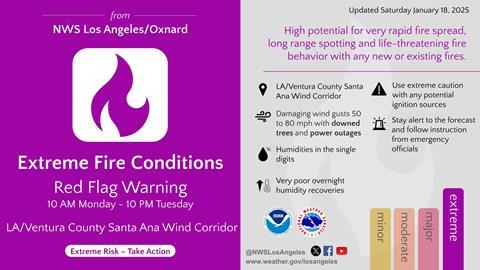
Instead of wildfires burning far away in the hills, the wildfires are in Greater Los Angeles, home to more than 18.3 million people.
Firas Saleh, director of product management at Moody’s said in a briefing document: ”This event is a tragic catastrophe. Already the most destructive wildfire event in Los Angeles County (pop. ~9.66 million) history, certainly now in the top three deadliest fires in the state, and potentially the costliest in U.S. history.
“Iit is hard to keep up with the latest extent of the destruction from now six separate wildfires at various locations predominantly to the west and north of the city, as well as areas inside the city.”
The first wildfire to be reported on January 7, was the Palisades Fire.
This started in the hills to the north of Pacific Palisades an affluent residential neighborhood nestled between the Santa Monica Mountains and the Pacific Coast, just two miles up the coast from Santa Monica.
The area is home to the Getty Villa collection of 44,000 Greek, Roman, and Etruscan antiquities dating from 6,500 BC to 400 AD, and also some of the most exclusive beachside properties in the U.S.
The Palisades fire burned over 23 acres. Los Angeles Fire Department Chief Kristin Crowley said: “it is safe to say that the Palisades fire is one of the most destructive natural disasters in the history of Los Angeles.”
The next fire was the Earon Fire, which burned over 14,000 acres, triggering evacuations in Altadena, Pasadena and Sierra Madre.
At least 25 people have died so far in the fires, with nine confirmed deaths from the Palisades fire and a further 16 from the Eaton fire. Other smaller fires have created untold damage throughout the region.
Saleh says: ”Other smaller fires are scattered to the north and west of the city, the largest of which is the Hurst Fire (~1,000 acres) close to Sylmar and San Fernando on the western edge of the Angeles National Forest.
”The Sunset Fire was reported at 6 p.m. on January 8 and impacted the world-famous Hollywood Hills. Evacuation orders were in place for Mulholland Drive and Hollywood Boulevard, a few blocks from Sunset Boulevard.”
Beyond the already significant damage to residential and commercial properties, the fires are taking a toll on critical infrastructure and inflicting severe losses on communities. Schools, essential services, and facilities, including power lines, transportation networks, and communication systems, face disruptions.
Some 19,000 customers were without power in Ventura County, and 96,000 customers in Los Angeles County, but power workers have significantly improved the situation.
Salah added: ”As flames encroached, panic led to abandoned vehicles in gridlocked traffic and significant damage to cars parked at properties, with the relentless flames consuming structures and vehicles alike.”
Firefighters fighting the Palisades Fire were hindered by a lack of water in fire hydrants, as hydrant tanks drained, and water pressure to the hydrants fell, a situation that has now been remedied.
Smoke is also a driver for implementing evacuation orders, as air quality plummets to unhealthy or hazardous levels. This is in addition to ‘boil orders’ or instructions to use bottled water, issued by water companies as fallen ash contaminates reservoirs and water storage facilities.
More warnings ahead
First responders have increased efforts to contain the fires, making progress after some of the worst wildfires in California’s history.
However, yesterday (Sunday 19th) the National Weather Service Los Angeles announced a red flag warning for further damaging winds and wildfire conditions.
It said: ”Damaging #SantaAnaWinds and extreme fire weather is expected Mon through Tue, with winds peaking Mon evening through Tue morning. Wind will be strongest along the traditional wind prone corridor of #LosAngeles and #Ventura counties. NOW is the time to prepare”.
This year’s wildfire season is already off to an unprecedented start. It is expected to be one of the most challenging yet, so preparation and awareness of the proper steps to take is crucial.
The World Health Organisation warns that wildfires have the ability to destroy not just land but also transportation, communications, power, gas services and water supply. They also lead to a deterioration of the air quality, which can have lasting effects.
“Wildfires hold not only a threat to the nature they engulf but also human lives, businesses and infrastructure systems that may extend well beyond that fireline,” said Josh Dozor, general manager of medical and security assistance at International SOS.
“It is essential that organisations have plans and practices in place to ensure staff accountability and business continuity, should they be affected.
”Education on the subject and heeding the advice of local emergency management will provide safety for employees, their families and the business.”
How to manage the threats
FEMA has announced that federal disaster assistance is available to the state of California to supplement recovery efforts in the areas affected by wildfires and straight-line winds.
Assistance can include low-cost loans to cover uninsured property losses and other programs to help business owners recover from the effects of the disaster.
Business owners who sustained losses in the designated areas can begin applying for assistance by registering online at www.DisasterAssistance.gov, by calling 1-800-621- 3362 or by using the FEMA App.
International SOS advises organisations to take steps to protect their people as well as prepare for all possible scenarios.
Should there be poor air quality, it is key to reduce exposure, allow employees to work from home and create a clean air space.
Dr Myles Druckman, global medical director at International SOS said: “Organisations should be well informed about the dangers of wildfires not just for their business but also for their employees’ wellbeing.
”They can take steps towards preparing for wildfire season by paying close attention to air quality updates from a trusted source such as IQAir, encouraging employees to limit their time outdoors if air quality is poor, ensuring their office space has clean air spaces made with portable air purifiers and having masks available for employees should they need to go outdoors.”
Managers with operations in at-risk areas should ensure they have comprehensive procedures in place to guarantee business continuity, factoring in the potential need for evacuation or relocation of the workforce.
Tips to share with your employees for wildfire preparedness:
- Preparation. Ahead of a wildfire, employees should prepare their residential property. They should take necessary measures to keep safe including removing flammable materials and vegetation in a 30-foot radius of structures. Outdoor furniture should be brought inside or placed in swimming pools. All windows and doors should be closed and left unlocked. Curtains should be taken down; fire-resistant window coverings should be considered. Sprinklers and running water should be cut off to preserve critical water pressure. Gas and electricity supply should be turned off to minimise residual damage.
- Evacuate. It is crucial that employees identify potential alternative accommodations in case evacuation is necessary. These may be friends’ or relatives’ homes in other towns, public shelters or hotels. It is recommended that they know how to reach their pre-identified accommodation and be ready to take alternative routes if major roads are disrupted. They should have a disaster plan in place, including meeting locations and communication plans, accounting for potential power disruption. It is important that an emergency supply kit is kept ready and multiple evacuation routes are planned.
- Air quality. Even if an employee is hundreds of miles away from a fire, it may impact the air quality in their area. To best prepare, it is advised to have air purifiers on hand and to stay indoors as much as possible. If it becomes necessary to go outdoors, ensure N95 masks are available.
- Emergency contacts. Police, emergency services, assistance centre and other local numbers should be saved. Employees should write down these details if their phone runs out of power and is unable to be recharged. They should also designate an out-of-area contact person in case of group separation.
- Inform: Provide employees with up-to-date information and resources to stay alert and understand the risks and implications caused by wildfires.





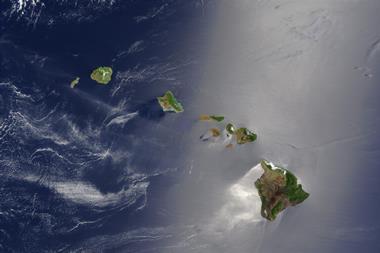
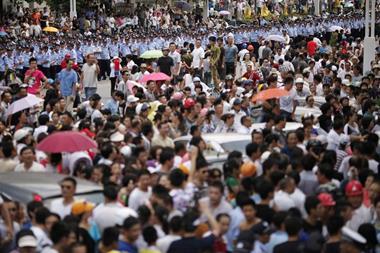

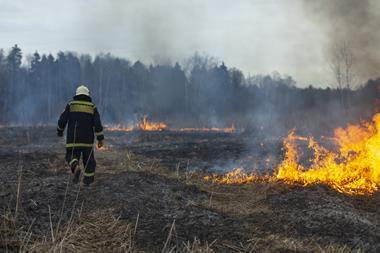
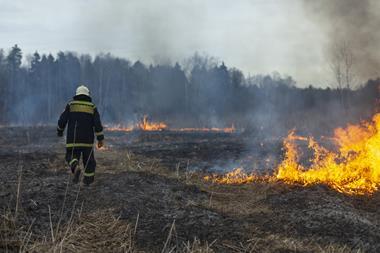

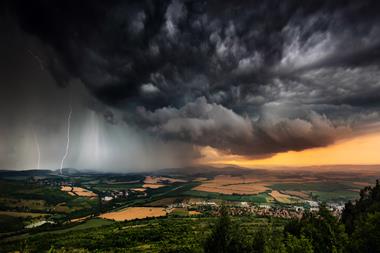
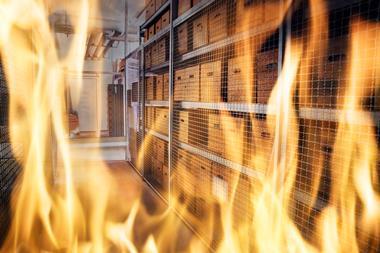
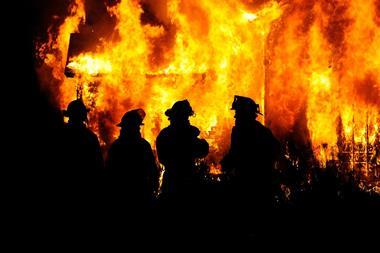
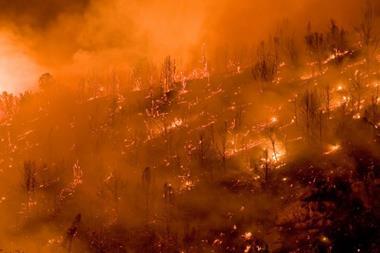
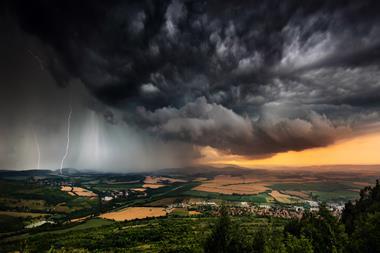




No comments yet